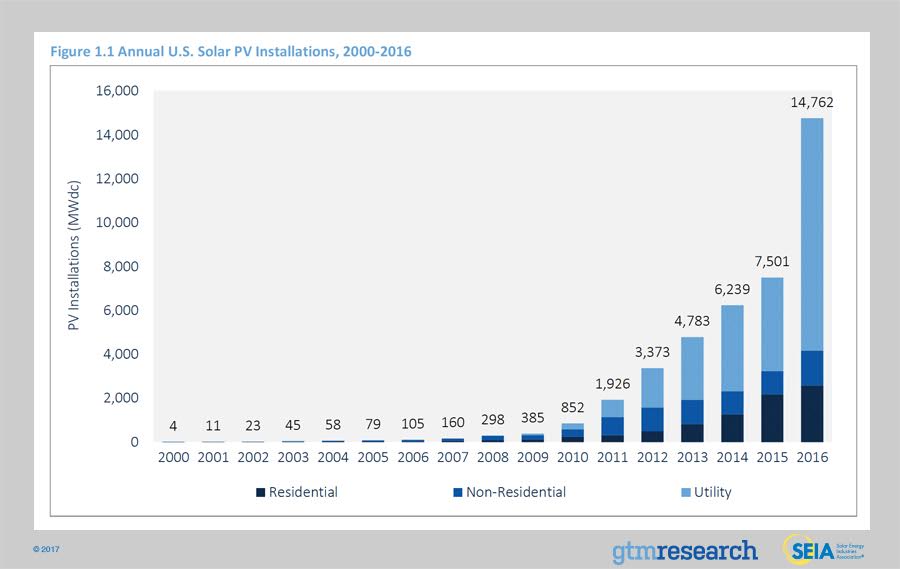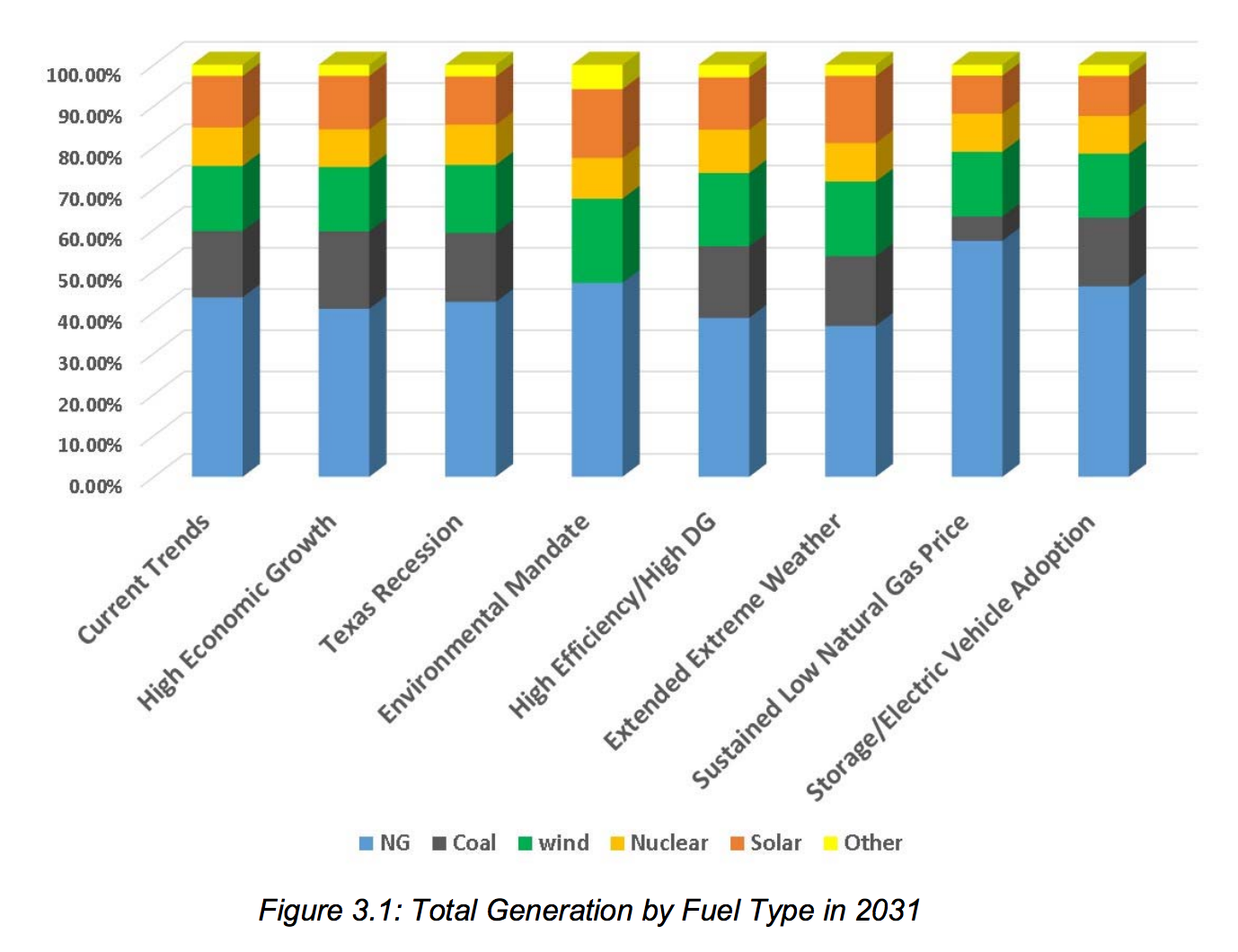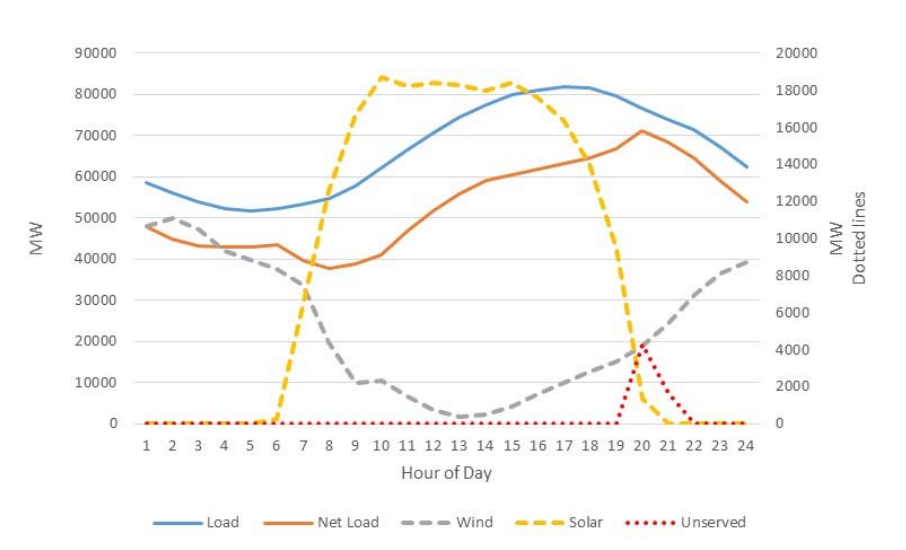By Drew O'Bryan
Solar energy is booming nationwide and utility companies are taking notice. To avoid being left behind as the energy sector moves into the future, many utilities are adding solar capacity to their energy portfolios.
2016 saw the largest number of new solar installations in history, nearly doubling 2015’s mark. The 14,800 megawatts (MW) of installed solar - enough to power roughly 1.5 million homes - accounted for 39% of all new generation in the U.S., beating natural gas and making solar the leader for all new resource capacity for the first time. As shown below, the sector’s largest growth came from the utility market (as opposed to solar rooftops), with more than 10,000 MW of energy being built by electric utilities.

Texas currently stands in 9th place for total solar capacity, but it ranked 6th in installed solar energy in 2016. Moving forward, the Electric Reliability Council of Texas (ERCOT) estimates significant growth for solar through 2030. In a recent report, they examined eight future scenarios, shown below, ranging in possibilities. For example, what if there was a strong environmental mandate on carbon pollution? Or what if there was just a continuation of current trends? All eight scenarios predict that solar energy will play a significant role in Texas’ future energy mix. Solar capacity in Texas is likely to expand by 14,500 - 40,500 MW in the next 13 years. To put that in perspective, there is approximately 1,215 MW of wind installed in Texas today.
ERCOT also claims that “the most significant finding from the generation expansion analysis was that solar generation could increasingly displace older coal and natural gas generation in ERCOT in the future.” The ability of renewable energy to displace fossil fuels as an energy resource provides important relief for Texans who suffer under the effects of climate change and pollution from coal and gas extraction and energy generation.

The more prices continue to decline for solar energy, the better the industry competes with natural gas. Greentech Media predicts that solar will become 8-10% cheaper each year from its current $1/MW rate for large scale production. By 2020, utility-scale solar prices should fall into the range of $0.80/MW, allowing for direct competition with natural gas installations even without a federal tax incentive.
Of course, the biggest issue presented by the expansion of renewable energy is that the sun doesn’t always shine and the wind doesn’t always blow. Fortunately, solar and wind have the ability to complement each other, as wind blows hardest at night after the sun sets. As shown in the graph below, even with ample solar and wind energy, Texas will still need additional energy at dusk - when people get home from work and turn on lights and appliances. During times like these and on calm, cloudy days it’s beneficial to have a way of storing energy to fill in the gaps in energy supply.

Energy storage will allow renewables to reach new heights. The most recognizable energy storage technology is batteries. On an average day, battery banks can store solar energy for use when lights turn on at sunset and before wind really picks up at night. Battery technology is developing rapidly, with companies racing to produce cost efficient solutions for energy storage. For example, Tesla hopes to lower prices with their new gigafactory, touted as the “world’s biggest factory", producing lithium ion batteries in Nevada.
In Texas, utilities like CPS Energy, Austin Energy, and Pedernales Electric Cooperative are also pursuing battery storage projects. CPS currently owns a 1 MW battery which is used to regulate energy from its 40 MW Alamo 1 solar farm. The next battery CPS is installing will be able to store and deploy 10 MW of power, enough to supply 2,500 homes, for one hour at a time. The battery project is being funded through a $3 million grant from the Texas Commission on Environmental Quality (TCEQ).
Similarly, Austin Energy, recipient of a $4.3 million grant from the Department of Energy in 2016, plans to install two battery projects to tie-in with two Austin-based solar farms. One battery will support a 2 MW solar farm, while the other will store energy from rooftop solar from residential and commercial residents in a mixed-use development neighborhood. Pedernales Electric Cooperative, located in Central Texas, has also received a Department of Energy grant of $3.24 million to pursue its own energy storage demonstration project as a way to stabilize the energy produced by the co-op’s multiple solar facilities.
In addition to battery storage, other types of storage have been employed by utilities. Pumped hydro storage has been used for decades, and uses water that is pumped uphill to a reservoir to be run through turbines when needed, while compressed air energy storage (CAES) places pressurized air into underground storage and released to power a generator on demand. In the future, different energy storage technologies will be important for various applications. As battery prices fall and alternative technologies develop, energy storage will have space to develop as rapidly as solar has over the past few years.